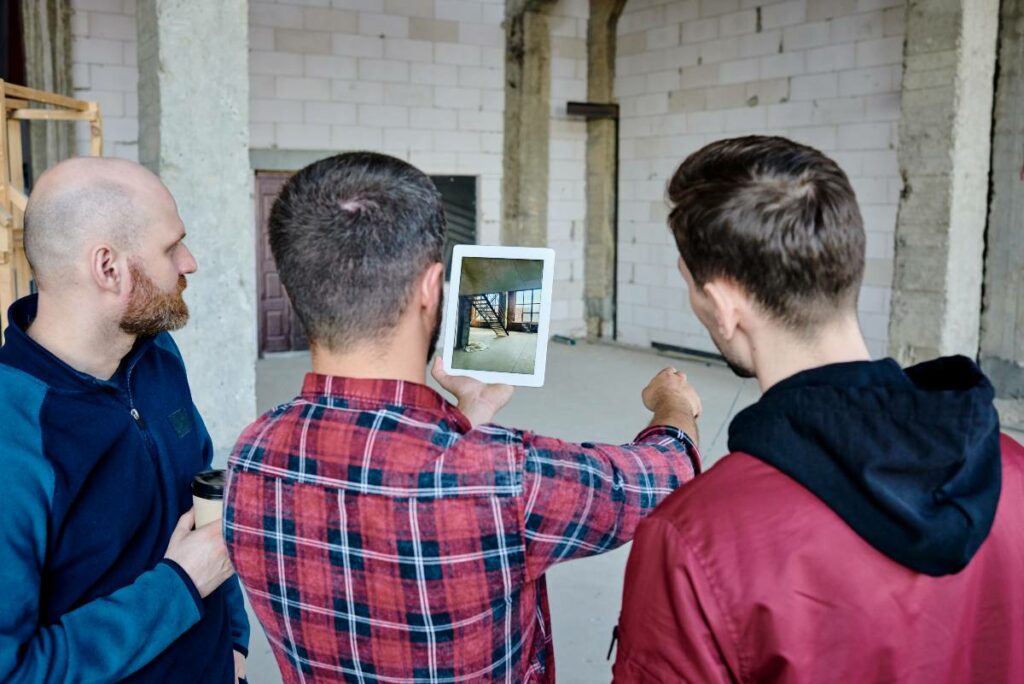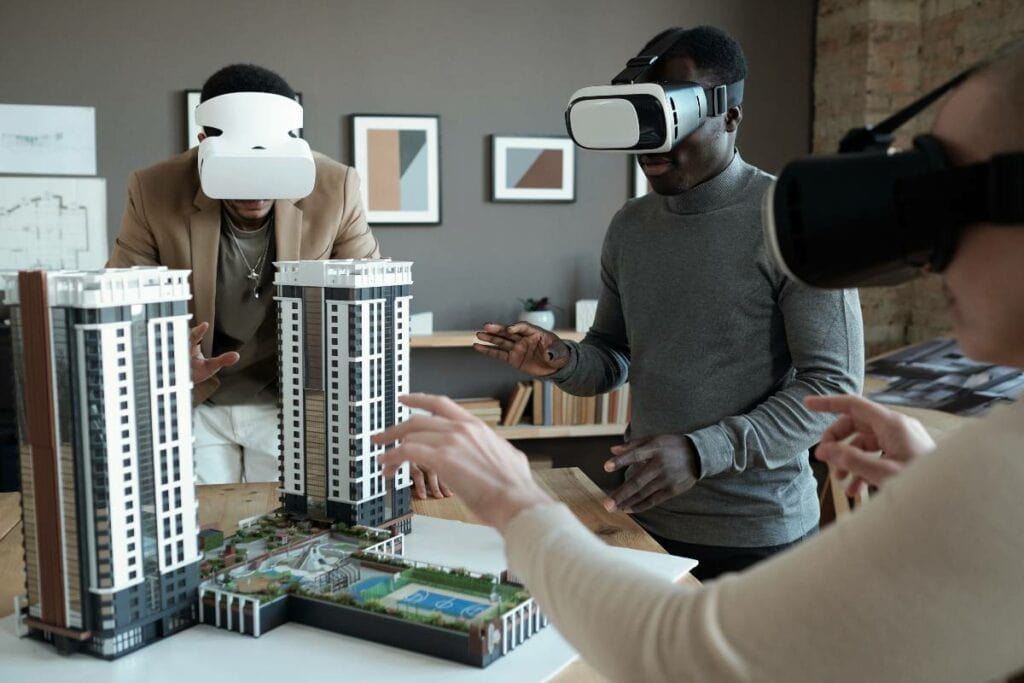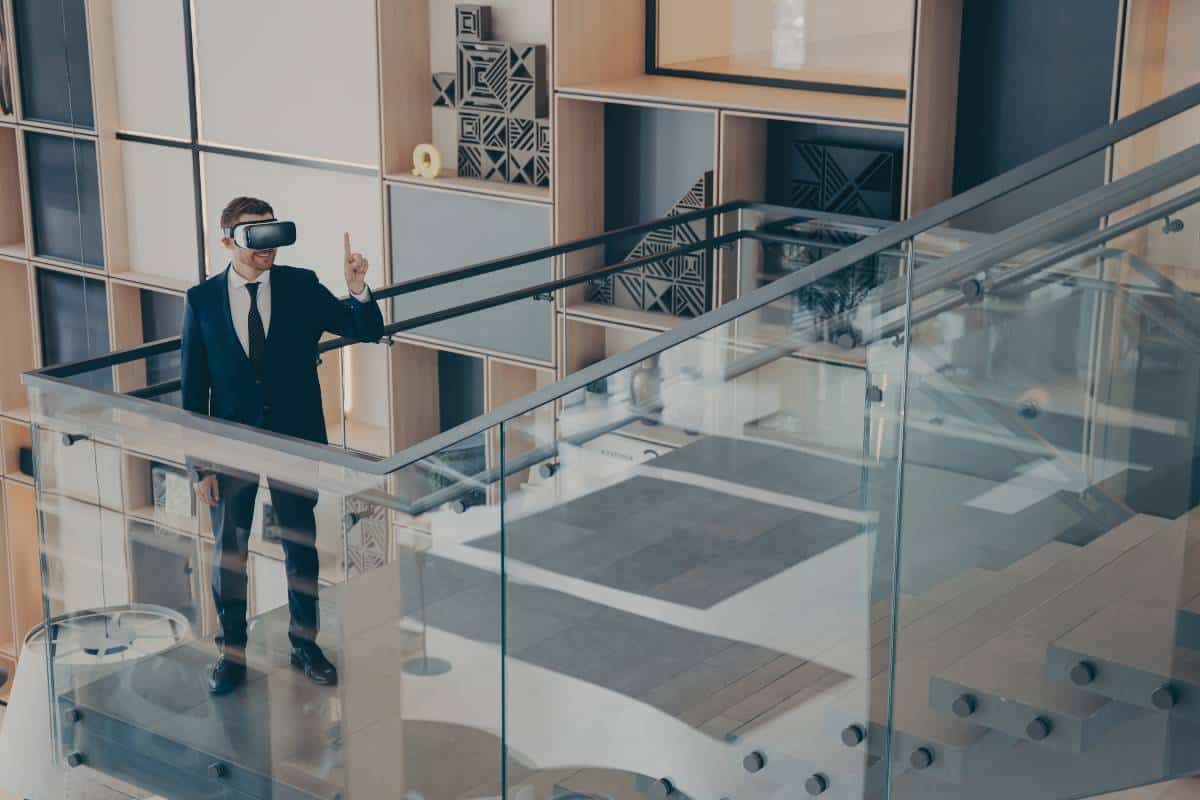As a seasoned professional with over 18 years of experience in commercial real estate, I’m always exploring innovative solutions to better serve my clients’ ambitions. Lately, I’ve been fascinated by augmented reality (AR) technology and its immense potential to revolutionize the CRE industry.
In simple terms, AR integrates digital information and visualizations with the user’s view of the real world. By leveraging AR, real estate agents can now offer stunningly realistic and interactive 3D tour experiences of spaces to potential buyers and tenants. As the adoption of these immersive technologies accelerates, AR is poised to disrupt antiquated workflows and unlock unprecedented value across the CRE sector.
Key Takeaways
- Augmented reality (AR) is revolutionizing the commercial real estate industry by enabling immersive and interactive 3D tours of spaces.
- These virtual experiences help streamline deal-making for buyers and brokers by allowing customized walkthroughs and faster-informed decisions.
- Emerging innovations like spatial computing and digital twins are unlocking advanced use cases for AR in CRE.
Table of Contents
Transforming CRE through Immersive Augmented Reality Tours
In this article, we’ll explore the transformational impact of AR across key areas:
- Revolutionizing property marketing
- Streamlining deal-making processes
- Unlocking advanced use cases through emerging innovations
- Overcoming barriers to widespread adoption
As adoption accelerates, AR has immense potential to transform property marketing, business operations, and facilities management. The global AR and VR market now generates an estimated $32.1 billion in revenue each year. This market is predicted to grow at a compound annual growth rate (CAGR) of 10.77% through 2028 as immersive technologies become more ubiquitous across industries like real estate.
Let’s dive in to visualize how augmented reality is redefining “property tours” in commercial real estate!
Revolutionizing Property Marketing with AR
AR empowers real estate professionals to reimagine traditional property showcasing approaches through interactive and appealing marketing materials. Some high-potential applications transforming this arena include:
Interactive 3D Tours for Remote Viewing
Immersive AR tours allow potential occupants to digitally step into—and freely navigate—photorealistic 3D models of buildings and spaces before physical visits. By simulating lighting, textures, and other environmental conditions, these experiences surpass 2D listings in conveying layouts, designs, and area ambiance.
Digital Staging to Showcase Property Potential
Empty spaces can be virtually staged with digital furnishing and décor to demonstrate aesthetic potential. Buyers can visualize custom arrangements rather than imagining possibilities. These virtually-enhanced environments better showcase space capabilities.
AR Mobile Apps to Aid On-Site Searches
AR-enabled smartphone apps overlay useful metadata when users scan surrounding areas, delivering at-a-glance insights during location searches. Integrated mapping helps buyers evaluate zoning information, foot traffic, transport access, and more.
VR Training Simulations for Brokers
VR modules offer rookie agents highly realistic onboarding experiences through simulated scenarios of showcasing properties, negotiating deals, etc. This boosts productivity.

Streamlining Deal-Making for Buyers and Brokers
By promoting deeper engagement and understanding of spaces, AR tours unlock immense value for buyers while improving brokers’ ability to close satisfactory deals.
Customized Virtual Walkthroughs
AR allows endless customization of environmental variables in virtual tours as per unique user needs. Customized experiences, optimized views, and layout changes assist decision-making.
Faster Informed Decision-Making
With detailed AR tours significantly accelerating due diligence, buyers can make quicker offers once spaces meeting requirements are identified. Fewer site visits before shortlisting streamline this process.
Higher Client Satisfaction Levels
AR unlocks unprecedented visualization before commitment, allowing buyers to validate choices more conclusively firsthand. By experiencing spaces remotely first, dissatisfaction upon moving in reduces.
Unique Value Proposition for Listings
For brokers and sellers, AR tours provide a differentiated value addition to cement listings above the competition. This attracts more promising tenants to spaces.
Integrating Emerging Technologies for Advanced Use Cases
As AR capabilities mature, integrating innovations like spatial computing, IoT and blockchain unlocks more advanced applications:
Multi-User Collaboration through AR
AR allows geographically distributed teams to simultaneously visualize and interact with virtual spaces. This facilitates remote collaboration on design mocked-ups and plan finalization.
Digital Twin Simulations
Hyperrealistic digital clone models of buildings can simulate performance across operational and ambient metrics like lighting, ventilation, energy usage, and more.
Spatial Computing for Predictive Analytics
Embedding spaces with intuitive AI to sense behaviors allows real-time analysis for forecasting future requirements. This is invaluable for strategizing renovations, expansions, etc.
Transforming Business Operations and Management
Beyond marketing, AR unlocks immense potential for enhancing ongoing property and facilities management:
Lifecycle Data Integration
Converging AR visualization and IoT sensor data from installations offers unified insights on asset status. Repairs, renovations, and restorations are vastly improved through tracking components virtually.
AR-Enabled Facilities Management
On-site technicians can access remote assistive AR overlays for receiving repair guidance, retrieving vital machine histories through barcode scans, and more. Spatial computed analysis also optimizes routing.
Spatial Mapping for Usage Analytics
Heatmaps revealing space utilization patterns help optimize room layouts for improving occupant convenience and infrastructural costs. Data transparency assists in planning.
Overcoming Adoption Barriers
To achieve more ubiquitous deployment, certain obstacles need overcoming:
Developer Community Growth
Nurturing specialized AR talent and an active community around spatial computing will accelerate innovation. Lower barriers to entry will draw fresh ideas.
Improving Cross-Platform Delivery
Optimized development kits ensuring consistency across devices remove fragmentation barriers for user-friendly delivery. Open libraries add momentum.
Cost and Skills Considerations
As hardware and developer costs gradually decline, easy-to-use no-code AR platforms will enable even non-specialists to create experiences, catalyzing adoption.
The Future with AR
Emerging use cases sound incredible but show immense promise. Here are innovations to watch:
- Holographic Interactions: Spatial interfaces allowing touch/gesture-based manipulation of holographic building data visualizations
- Multi-Sensory Engagement: Simulating architecture through expanded sensory abstractions — airflow, sounds, brightness — for evaluating designs
- Co-Creation in the Metaverse: Collaborative 3D virtual environments with simulated occupancy for architects and stakeholders to collectively design buildings and spaces

FAQs
What are the key benefits of AR for commercial real estate?
Augmented reality enables remote property tours, customized spaces matching buyer preferences, and swift shortlisting through enhanced visualization.
How can brokers differentiate offerings with AR?
Brokers can develop interactive AR tours for enriched marketing, guide clients through customized digital walkthroughs, and improve listing reliability by reducing dissatisfaction.
What future innovations are expected in AR for real estate?
Expected innovations include collaborative metaverse design environments, cross-device delivery for consistent user experiences, and intuitive spatial interfaces leveraging gestures.
How can facilities managers tap the potential of AR?
AR can optimize maintenance through status tracking, boost productivity via remote technician assistance, and enhance space planning using utilization heatmap data.
What skills are vital for CRE specialists to thrive with AR?
Spatial thinking, immersive data visualization proficiency, technological adaptivity, analytical and emotional intelligence blending, and change-ready mindsets will prove vital.
How can stakeholders circumvent the risks of dependence on AR?
Risk mitigation tactics involve building redundancies for mission-critical functions, extensive beta-testing before implementation, and cultivating digitally resilient teams adept at switching modalities.
Conclusion
I understand searching for commercial real estate can feel overwhelming. You likely have big dreams for your business, but finding the right space to support your vision takes time and effort. Please know you don’t have to figure this out alone. I’m here as your trusted advisor to ease your worries and make this journey successful and even exciting! Let’s connect for a complimentary consultation to explore how augmented reality could benefit your search.
This innovative technology allows you to evaluate spaces remotely through immersive 3D tours customized to your needs. I’ll listen carefully to understand your top priorities, preferred designs, budget, and other key factors.
My goal is to leverage AR to pre-filter the most promising options so we can narrow inefficiently on commercial real estate that fulfills your strategic vision and enables your company to thrive.
This will maximize value for you as the owner over time. I’m committed to making your commercial real estate dreams a reality – schedule a consultation today!




